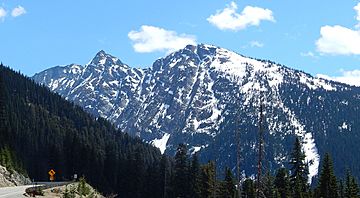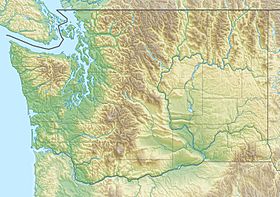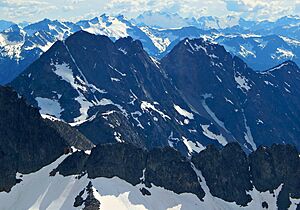Stiletto Peak facts for kids
Quick facts for kids Stiletto Peak |
|
|---|---|

Stiletto Peak seen from North Cascades Highway
|
|
| Highest point | |
| Elevation | 7,660 ft (2,335 m) |
| Prominence | 380 ft (120 m) |
| Geography | |
| Location | Chelan County, Washington, U.S. |
| Parent range | North Cascades |
| Topo map | USGS McAlester Mountain |
| Climbing | |
| Easiest route | Scrambling |
Stiletto Peak is a tall mountain in Washington state. It stands 7,660 feet high. This peak is part of the Methow Mountains, which are a smaller group within the larger North Cascades range.
Stiletto Peak is located inside the Stephen Mather Wilderness. It sits on a ridge with two other peaks nearby: Switchblade Peak and Jackknife Peak are to its east. The mountain is also right on the edge of North Cascades National Park. Water from the north side of Stiletto Peak flows into Bridge Creek. Water from the south side drains into the East Fork Bridge Creek.
Contents
Understanding the Climate of Stiletto Peak
The weather around Stiletto Peak is mostly shaped by the Pacific Ocean. Most weather systems start over the ocean. They then travel northeast towards the Cascade Range.
How Mountains Affect Weather
As these weather systems reach the North Cascades, the tall peaks force the air upwards. This makes the air cool down and drop its moisture. This moisture falls as rain or snow. The western side of the North Cascades gets a lot of rain and snow. This is especially true during the winter months.
Seasonal Weather Patterns
In winter, the weather is often cloudy. However, in summer, large high-pressure systems form over the Pacific Ocean. These systems bring clear skies. So, there is often little or no cloud cover during the summer. Because the ocean influences the weather, the snow tends to be wet and heavy. This type of snow can lead to a high risk of avalanches.
The Geology and Formation of the North Cascades
The North Cascades area has very rugged land. You can see jagged peaks, sharp ridges, and deep valleys carved by glaciers. These amazing landscapes were created by geological events that happened millions of years ago. These events caused big changes in elevation. This led to different climates and types of plants in various ecoregions.
How the Mountains Were Formed
The Cascade Range began forming millions of years ago, during the late Eocene Epoch. At that time, the North American Plate was slowly moving over the Pacific Plate. This movement caused many volcanic eruptions. Also, small pieces of the Earth's crust, called terranes, joined together. This process helped create the North Cascades about 50 million years ago.
The Impact of Glaciers
During the Pleistocene period, which started over two million years ago, glaciers repeatedly moved across the land. As they moved, they scraped away rock and left behind debris. The river valleys in this area often have a "U" shape. This shape is a clear sign that glaciers once moved through them. The combination of land being pushed up (called uplift) and cracks in the Earth's crust (called faulting), along with the action of glaciers, created the tall peaks and deep valleys we see in the North Cascades today.




